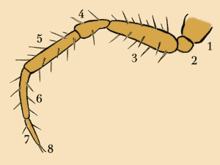Patella (jaw bearer)

The patella (plural: patellae) is a member of the legs and pedipalps of the jawbone carriers (Chelicerata), which lies between the femur and the tibia . As with other leg links, this is a solid tube that is connected to the adjacent leg links by a soft and non- sclerotized joint area and can be moved independently by muscles.
A patella occurs in the blueprint of the jaw-claw bearers, which mainly include the spiders and scorpions . It is different within the individual groups and is present on all extremities. Usually it is a short leg segment of roughly bell-shaped shape, the narrow upper end of which sits on the femur and is broadly connected to the tibia. In contrast , the insects , myriapods and crustaceans grouped as mandibular animals have no patella.
It was named in analogy to the human leg with a kneecap (patella) between the thigh (femur) and the lower leg (tibia). However, there is no homology of the individual members between arachnids and vertebrates.
According to studies in which the gene expression in embryonic leg systems was compared in different arthropod groups, the patella and tibia of the Chelicerata are homologous to the tibia of the other arthropods. In the Chelicerata there is a gene specific for this group of animals, the expression of which determines the formation of the patella. It is a paralogue to a gene that is involved in the formation of the leg joints in all arthropods, which is called dachshund ( dac for short ) (if this gene is mutated , the legs are malformed and significantly shortened, which reminded the description of a dachshund ). If the gene product of this gene, called dachshund 2 , is missing, the patella and tibia fuse into one limb. Functionally, it is assumed that the patella, as an additional short leg segment, increases the mobility of the leg.
supporting documents
- ↑ John T. Hjelle: Anatomy and Morphology. In: Gary A. Polis (Ed.): The Biology of Scorpions. Stanford University Press, Stanford 1990, ISBN 0-8047-1249-2 , pp. 9-63, here p. 6.
- ↑ Peter Weygoldt : Chelicerata, Arachnids In: W. Westheide, R. Rieger (Ed.): Special Zoology. Part 1: Protozoa and invertebrates. Gustav Fischer Verlag, Stuttgart / Jena 1997, ISBN 3-437-20515-3 , p. 449.
- ↑ a b Hannes Paulus : Euarthropoda, Arthropod, ieS In: W. Westheide, R. Rieger (Ed.): Special Zoology. Part 1: Protozoa and invertebrates. Gustav Fischer Verlag, Stuttgart / Jena 1997, ISBN 3-437-20515-3 , pp. 436–437.
- ↑ Natascha Turetzek, Matthias Pechmann, Christoph Schomburg, Julia Schneider, Nikola-Michael Prpic: Neofunctionalization of a Duplicate dachshund Gene Underlies the Evolution of a Novel Leg Segment in Arachnids. Molecular Biology and Evolution 33 (1), 2015; Pp. 109-121. doi: 10.1093 / molbev / msv200